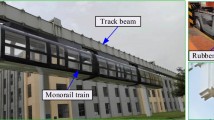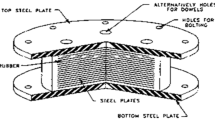Abstract
This study aims to develop a multiple excitation system that improves the identification of modal parameters for the vibration testing of tires. Rubber, the main tire material, shows high damping characteristics. Therefore, the resonance peaks broaden, and it is difficult to identify the modal parameters. In the equations of motion, the damping force is proportional to the velocity of the equivalent mass and acts in the opposite direction of motion. This study proposes a novel multiple excitation testing method using velocity feedback control to counteract the damping force. The proposed method provides frequency response function (FRF) data with peak shapes. Three shakers were used to excite an automotive tire, and they were driven with forced vibration and velocity feedback signals. Using the proposed method resulted in shaped resonance peaks of the FRF and lower damping characteristics. Furthermore, the natural frequencies and mode shapes obtained by the proposed method was consistent with the single-shaker testing data obtained by the conventional method. Therefore, the proposed method primarily influences the damping characteristics of the vibration system as a target and facilitates the identification of modal parameters.






Similar content being viewed by others
References
Bolton, J.S., Kim, Y.J.: Wave-number domain representation of tire vibration. J. Acoust. Soc. Am. 107, 2901 (2000). https://doi.org/10.1121/1.428795
Kindt, P., Sas, P., Desmet, W.: Measurement and analysis of rolling tire vibrations. Opt. Lasers Eng. 47, 443–453 (2009). https://doi.org/10.1016/j.optlaseng.2008.06.017
Mange, A., Atkinson, T., Bastiaan, J., Baqersad, J.: An optical-based technique to obtain vibration characteristics of rotating tires. SAE Int. J. Veh. Dyn. Stab. NVH 3(3), 197–208 (2019). https://doi.org/10.4271/10-03-03-0013
Cao, R., Bolton, J., Black, M.: Force transmission characteristics for a loaded structural-acoustic tire model. SAE Int. J. Passeng. Cars Mech. Syst. 11(4), 305–319 (2018). https://doi.org/10.4271/06-11-04-0025
Kuznetsov, A., Mammadov, M., Sultan, I., et al.: Optimization of improved suspension system with inerter device of quarter-car model in vibration analysis. Arch. Appl. Mech. 81, 1427–1437 (2011). https://doi.org/10.1007/s00419-010-0492-x
Alobaid, F.T., Taheri, S.: Modal analysis of a discrete tire model with a contact patch and rolling conditions using the finite difference method. Dynamic 2, 40–62 (2022). https://doi.org/10.3390/dynamics2020003
Nackenhorst, U., Brinkmeier, M.: On the dynamics of rotating and rolling structures. Arch. Appl. Mech. 78, 477–488 (2008). https://doi.org/10.1007/s00419-008-0216-7
Wheeler, R., Dorfi, H., Keum, B.: Vibration modes of radial tires: measurement, prediction, and categorization under different boundary and operating conditions. SAE Technical Paper 2005-01-2523. (2005). Doi: https://doi.org/10.4271/2005-01-2523
Wood, A.C., Krylov, V.V., Walsh, S.: Investigation of sound radiation by automotive tyres vibrating at low resonant frequencies. Proc. ISMA 2014 including USD2014, 1797–1811 (2014)
Elsalama, A.A., Gohary, M.A., EI-Gamal, H.A.: Modal analysis on tire with respect to different parameters. Alex. Eng. J. 56(3), 345–357 (2017). https://doi.org/10.1016/j.aej.2016.09.022
Matsubara, M., Tajiri, D., Ise, T., Kawamura, S.: Vibrational response analysis of tires using a three-dimensional flexible ring-based model. J. Sound Vib. 408, 368–382 (2017). https://doi.org/10.1016/j.jsv.2017.07.041
Phillips, A.W., Allemang, R.J., Fladung, W.A.: The complex mode indicator function (CMIF) as a parameter estimation method. Proc.SPIE Int Soc. Opt. Eng. 3243, 705–710 (1998)
Malekjafarian, A., Ashory, M.R., Khatibi, M.M.: Identification of inertia properties from the results of output-only modal analysis. Arch. Appl. Mech. 83, 923–937 (2013). https://doi.org/10.1007/s00419-012-0727-0
Kitahara, A., Yoshimura, T.: Modal analysis of cylindrical shell using circumference reduction method and nonlinear least squares approach. Proc. ISMA 2014 including USD2014, 1747–1753 (2014)
Tajiri, D., Matsubara, M., Ojiro, M., Sato, M., et al.: Modal identification of motorcycle tires using circumferential wave number decomposition. SAE Int. J. Veh. Dyn. Stab. NVH 5(3), 317–331 (2021). https://doi.org/10.4271/10-05-03-0022
Tang, S., Liu, S., Zhao, D., et al.: Vibration response analysis of plate with microfloating raft arrays under multipoint random excitation. Arch. Appl. Mech. 91, 4081–4096 (2021). https://doi.org/10.1007/s00419-021-02028-7
Boulton, P.I., Kavanagh, R.J.: A method of producing multiple noncorrelated random signals from a single Gaussian noise source. IEEE Trans. Appl. Ind. 82(65), 46–52 (1963). https://doi.org/10.1109/TAI.1963.5407860
Izumi, T.: Simple method for generation of multiple normal random signals. IEEE Trans. Acoust. Speech Signal Process. 37(12), 1985–1987 (1989)
Kurita, Y., Oura, Y., Matsuda, S., Nishide, H.: Driving at resonance point of multi-degree-of-freedom system by decentralized control: Development of control method and verification of basic performance (mechanical systems). Trans. Jap. Soc. Mech. Eng. Ser. C 76(763), 557–564 (2010). https://doi.org/10.1299/jsdd.5.180
Tanaka, T., Kurita, Y., Oura, Y., Uehara, D.: Driving at resonance point of multi-degree-of-freedom system by decentralized control (Excitation of natural vibration in the large degree of freedom and large damping system by local feedback control and cross feedback control). Trans. JSME (2020). https://doi.org/10.1299/transjsme.19-00422
Tanaka, T., Tamura, T., Oura, Y.: Excitation of ultrasonic natural vibrations by multi-excitation using decentralized control for failure monitoring. In: Proc. of the ASME 2021 conference on smart materials, adaptive structures and intelligent systems, No. SMASIS2021-67457 (2021)
Matsubara, M., Saito, A., Kawamura, S.: Estimation of modal parameters by using the ratios of imaginary to real parts of frequency response functions. Arch. Appl. Mech. 91, 1179–1191 (2021). https://doi.org/10.1007/s00419-020-01817-w
Acknowledgments
This work was financially supported by a research grant from the Suzuki Foundation.
Author information
Authors and Affiliations
Corresponding author
Ethics declarations
Conflict of interests
The authors have no competing interests to declare that are relevant to the content of this article.
Additional information
Publisher's Note
Springer Nature remains neutral with regard to jurisdictional claims in published maps and institutional affiliations.
Rights and permissions
Springer Nature or its licensor (e.g. a society or other partner) holds exclusive rights to this article under a publishing agreement with the author(s) or other rightsholder(s); author self-archiving of the accepted manuscript version of this article is solely governed by the terms of such publishing agreement and applicable law.
About this article
Cite this article
Matsubara, M., Tanaka, T., Tajiri, D. et al. Vibration testing of tires by multiple excitations coupled with velocity feedback control. Arch Appl Mech 93, 1139–1148 (2023). https://doi.org/10.1007/s00419-022-02318-8
Received:
Accepted:
Published:
Issue Date:
DOI: https://doi.org/10.1007/s00419-022-02318-8




